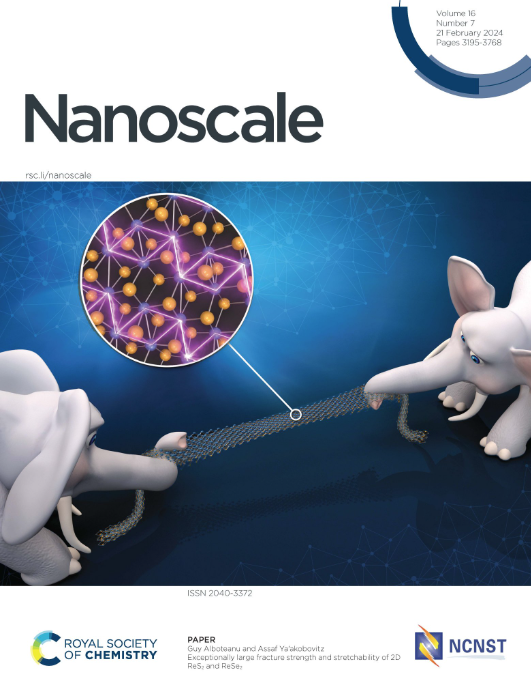Surface palladium nanoparticles in ionic liquids modified with phosphorus ligands for enhanced catalytic semi-hydrogenation
IF 5.8
3区 材料科学
Q1 CHEMISTRY, MULTIDISCIPLINARY
引用次数: 0
Abstract
Thermodynamic stability of nanoparticles necessitates the use of stabilizing agents to provide steric and electronic protection. Nevertheless, their activity and selectivity remain suboptimal under moderate reaction conditions. In this study, we present high-performance Pd nanoparticles with a distinctive Pd-phosphate surface that is akin to a “quasi nano-frustrated Lewis pair” architecture, where electron donation from ionophilic phosphine species enhances the electron density of the Pd NPs. Solid state NMR and XPS analyses disclose the strong coordination of phosphine species on Pd NPs. DFT calculations reveals the geometry and conformations of the coordinated phosphine, where one of the phenyl rings is nearly parallel to the facets of the nanoparticle, such interaction occurs through the six carbon atoms of the π system. We investigate the structure-activity relationships (SARs) exhibited by these NPs in the efficient semi-hydrogenation of phenylacetylene (TOF = 3.85 s⁻¹), 2-cyclohexen-1-one (TOF = 0.8 s⁻¹), and 1,3-cyclohexadiene (TOF = 12.82 s⁻¹) at 40°C and 2-4 bar H₂ in BMIm.NTF2 ionic liquid. The higher activity and selectivity are related to; (i) the formation of ionic liquid cages/membrane around NPs akin to catalytic active membranes that tune the diffusion affinity of reactants, reactive intermediates, and products to catalytic active sites, and (ii) the hindrance provided by the Pd-P bonds.磷配体修饰离子液体中表面钯纳米颗粒增强催化半加氢作用
纳米颗粒的热力学稳定性需要使用稳定剂来提供空间和电子保护。然而,在中等反应条件下,它们的活性和选择性仍然不是最佳的。在这项研究中,我们提出了高性能的Pd纳米颗粒,其具有独特的Pd-磷酸表面,类似于“准纳米受挫刘易斯对”结构,其中来自亲离子膦物种的电子捐赠增强了Pd NPs的电子密度。固体核磁共振和XPS分析揭示了磷化氢在Pd NPs上的强配位。DFT计算揭示了配位膦的几何形状和构象,其中一个苯基环几乎平行于纳米粒子的表面,这种相互作用通过π系统的六个碳原子发生。我们研究了这些NPs在苯乙炔(TOF = 3.85 s⁻¹)、2-环己烯-1- 1- 1 (TOF = 0.8 s⁻¹)和1,3-环己二烯(TOF = 12.82 s⁻¹)在40°C和2-4 bar h2的BMIm中有效半加氢过程中所表现出的构效关系(SARs)。NTF2离子液体。较高的活性和选择性与;(1)在NPs周围形成离子液体笼/膜,类似于催化活性膜,调节反应物、反应中间体和产物对催化活性位点的扩散亲和力;(2)Pd-P键提供的阻碍。
本文章由计算机程序翻译,如有差异,请以英文原文为准。
求助全文
约1分钟内获得全文
求助全文
来源期刊

Nanoscale
CHEMISTRY, MULTIDISCIPLINARY-NANOSCIENCE & NANOTECHNOLOGY
CiteScore
12.10
自引率
3.00%
发文量
1628
审稿时长
1.6 months
期刊介绍:
Nanoscale is a high-impact international journal, publishing high-quality research across nanoscience and nanotechnology. Nanoscale publishes a full mix of research articles on experimental and theoretical work, including reviews, communications, and full papers.Highly interdisciplinary, this journal appeals to scientists, researchers and professionals interested in nanoscience and nanotechnology, quantum materials and quantum technology, including the areas of physics, chemistry, biology, medicine, materials, energy/environment, information technology, detection science, healthcare and drug discovery, and electronics.
 求助内容:
求助内容: 应助结果提醒方式:
应助结果提醒方式:


